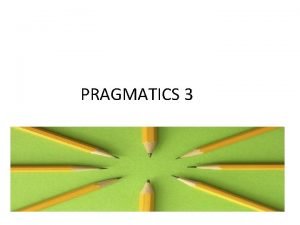CONVERSATION AND PREFERENCE STRUCTURE In every conversation there



- Slides: 3

CONVERSATION AND PREFERENCE STRUCTURE In every conversation there are certain elements that can be analized. Those elements are: 1) Conversation Analysis - Floor: It means that a person is allowed to speak when he is in an interaction. -Turn: having control -Turn-taking: Anyone can lead an interaction. -Conversation. Change of turn: When speakers do taking turn at holding the floor in communication, they cooperate and share equally. (1) 2) Pauses Are those periods of time in which a speaker doesn´t say anything (2 or 3 seconds). Those periods have an implicit meaning which goes from hesitation to indiference or boring.

3)Overlaps (//) Double slash It occurs when both speakers are trying to speak at the same time, showing closeness in expresing ideas or feelings. for example: Jane: Don´t you remember when Erick was in Oleg: // In Texas whit Mary. Jane: yeah. 4) Backchanels are certain sounds, expressions or gestures which purpose is to give feedback in a conversation. For example: (In a phone call) Ann: We were in there for 2 hours. . . then Max told us about his new car. . . moreover Clarice appeared and said to us. . . Carl: . . mmmm. . uhhh. 5) Conversation style There are 2 styles which are: High involvement style and high considerateness style. -High involment style: It descrives a fast interaction -High considerateness style: It´s close to a polite conversation, with long pauses and a moderate speed without interruptions or overlaps.

6) Adjacency Pairs These are sequences of two utterances. A first part and a second part. (The first part is performed by one of the speakers, and the second one by the other one) For example: Part 1 -Hello -How you been? -Bye Part 2. Hi. cool. see you 7) Preference structure Basically, a first part that contains a request or an offer is typically made in the expectation that the second part will be an acceptance. For example: Speaker 1 Speaker 2 -Would you like to come? . Yes





